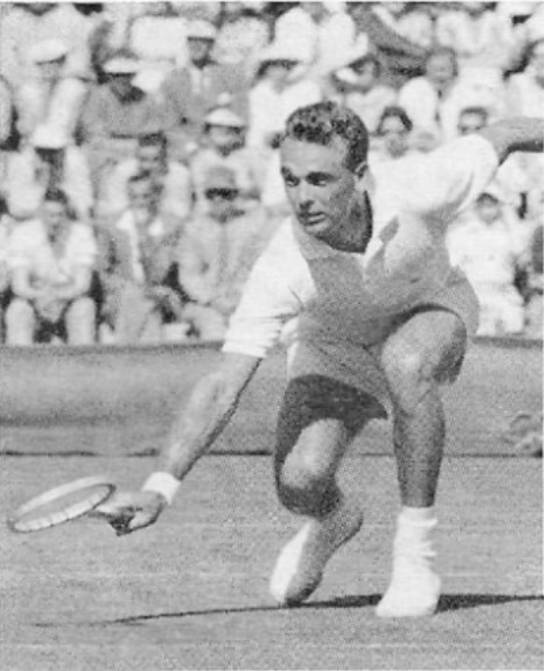One hundred years ago, on August 30th, 1923, the tennis world was preparing for the final round of the Davis Cup. Bill Tilden and Bill Johnston would represent the home side at Forest Hills against a challenge from Australia.
Not far to the southwest, in Tilden’s home town of Philadelphia, Vic Seixas was born. He got a late start on his tennis career, flying planes for the Army Air Corps during World War II and getting his degree from the University of North Carolina. Eventually, though, he played Davis Cup himself, contesting seven consecutive Challenge Rounds between 1951 and 1957 and helping bring the Cup home in 1954.
Seven decades later, remarkably, Vic is still with us. Today he celebrates his 100th birthday.
Seixas (pronounced SAY-shus) was the perpetual underdog. His first serve was erratic, and his groundstrokes were shaky. Jack Kramer never offered him a contract to turn pro because he was “simply not good enough.”
Yet between 1952 and 1957, the Philadelphian won singles titles at Wimbledon and Forest Hills, and he piled up another 13 major doubles championships. What he lacked in technique he made up for with sheer doggedness. He was the fittest American player of his generation. He fought for every point in an era when his rivals would sometimes save energy by tanking games, even entire sets. When he couldn’t create an opportunity to move forward, he hit his best shot and rushed the net anyway.
Seixas’s unlikely success added up to an outstanding career. Last year, I rated him the 66th best player–man or woman–of the last hundred years. The International Tennis Hall of Fame inducted him in 1971.
How hard was Vic willing to work? The scores tell the story. At Roland Garros in 1950, his first major abroad, he never gave an inch to Jaroslav Drobný, losing 7-5, 17-15, 5-7, 6-4. At Wimbledon a month later, he won his first grand slam quarter-final over South African Eric Sturgess, 9-7, 6-8, 3-6, 6-2, 7-5.
In 1953, the Wimbledon draw opened up for him, but that didn’t mean it would be easy. He advanced past Australian Mervyn Rose in the semis, but only after a battle: 6-4, 10-12, 9-11, 6-4, 6-3. He went to the brink to beat another Aussie, Rex Hartwig, at the French the next year. The final score on that one was 8-6, 3-6, 6-3, 5-7, 10-8.
Vic’s nemesis was Ken Rosewall, who beat him nine of the ten times they met at majors or in Davis Cup play. But the American never quit fighting. He lost only two of the decisions in straight sets. And the one victory was a particularly consequential one. In the 1954 Davis Cup Challenge Round, Tony Trabert scored an opening rubber win against the Australian hosts. Seixas came through with a four-set upset of Rosewall. He then secured the Cup title the next day, partnering Trabert to beat Rosewall and Lew Hoad in the doubles.
After losing the 1957 Challenge Round, Seixas–then 34 years of age–announced that he was finished with international tennis. He never made any money from the amateur game, and he went to work for Goldman Sachs.
But he never really called it quits. The year after his “retirement,” he played six tournaments, winning one of them. For another decade, the marathon man kept threatening to go five sets. In 1960, he won his third-rounder at Forest Hills despite losing the fourth set, 13-15. In 1963, he lost at the same stage, trading a 13-11 frame for a 14-12 before falling in five to Larry Nagler, a man 17 years his junior.
He saved the most outrageous set for his friends in Philadelphia. In 1966, he played some of his best tennis in years, picking up titles in Tulsa and Detroit. He won his first two matches easily at the Pennsylvania Lawn Tennis Championships in Haverford, earning a place in the round of 16 against an Australian up-and-comer named Bill Bowrey.
The match began on July 20th, at 4:15 in the afternoon. At 6:30, they still hadn’t decided the first set. Seixas saved set point at 15-16. He saved another one at 17-18. Then another at 29-30, and one more at 32-33 before finally giving way. Bowrey took the opener, 34-32.
In the time it took to play that one set, three matches were completed on the next court. Rosie Casals lost, then Tony Roche and Stan Smith scored singles victories. It was quite the contrast of generations: None of those players were even born when Seixas turned 21.
Somehow, the veteran shook off the loss of a 66-game set. “There was fire to Vic’s service, brilliance to his volley and his driving as he fought for every point,” wrote the Philadelphia Inquirer. He didn’t lose serve again. In three hours and 35 minutes, he defeated Bowrey, 32-34, 6-4, 10-8.
Tennis players are a long-lived lot. Rosewall is still going strong at 88, and Trabert died in 2021, at age 90, to take just two examples. Seixas was the stubbornest fighter of his generation, battling his fellow champions to the last point. He didn’t always beat them, but he may yet outlast them all.
* * *
Subscribe to the blog to receive each new post by email:
